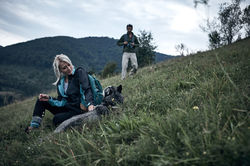Essential Skills
 |  |  |
|---|---|---|
 |  |  |

5D's of Navigation

The Five D’s
"Every time you plan or navigate from one waypoint to another, you need to consider the 5 D’s
-
Direction – This could be simply east, north-west or a specific magnetic bearing.
-
Distance – How far do you have to walk? This could be to the next waypoint or until the next feature.
-
Duration – How long should this leg take? Use this as a gross error check to see whether a mistake has been made in transit.
-
Description – What should you be looking out for en-route? Remember the analogy of a map being a book that you can read. Highlight features, boundaries or landmarks.
-
Destination – A description of what your target is at the end of the leg. This could be a trig pillar, the corner of a wood or a junction in a boundary etc. It is also useful to highlight any other feature that would indicate an error in your navigation, this is known as a gross error check."
Description of the 5D's taken from onthehills.uk article
Map Basics
The Map and How to Use It
In a scale of 1:50,000 : this means that 1 centimetre on the map equals 50,000 centimetres (or 500 metres) on the ground. Two centimetres on the map is equivalent to 1 kilometre on the ground.
1:25,000: 1cm on map equals 25,000cm (or 250m) on the ground. 4cm on map equals 1km on the ground.
1:50,000. 1cm = 500m. 2cm=1km
1:25,000. 1cm = 250m. 4cm =1km
So 1:25,000 is more detailed and closer up.
Grid References
These lines are called ‘eastings’ - along the corridor and northings’ (the horizontal lines) up the stairs and are numbered from 00 to 99 in 100km blocks.
To use the grid lines to identify a location, simply read along the numbers on the eastings first, and then the northings.
Top Tip: If you have trouble remembering the order, say… along the corridor, THEN up the stairs.
This ‘four figure’ grid reference refers to a square 1km by 1km, which is a large area on the ground. It is standard practice to give a six figure grid reference, which identifies a much more usefully-sized square of 100 metres by 100 metres.
For more details visit:
https://www.mountaineering.scot/safety-and-skills/essential-skills/navigation/the-map-and-how-to-use-it
A Beginner's Guide to Grid References
Click Image below for a Guide to Grid References

